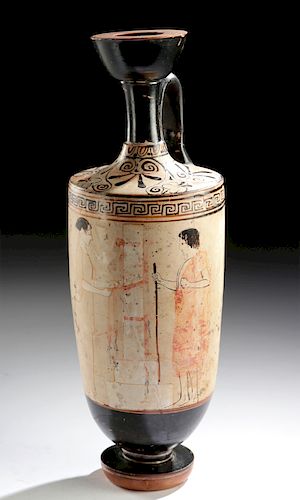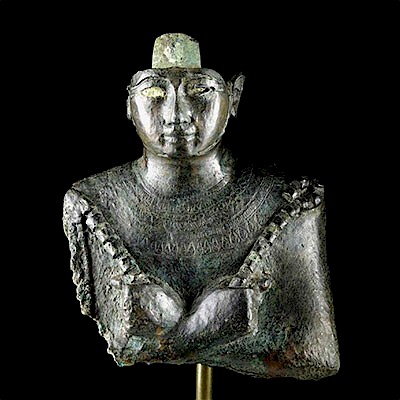Exceptional Greek Attic White Ground Lekythos w/ TL
Lot 18a
About Seller
Artemis Gallery
686 S Taylor Ave, Ste 106
Louisville, CO 80027
United States
Selling antiquities, ancient and ethnographic art online since 1993, Artemis Gallery specializes in Classical Antiquities (Egyptian, Greek, Roman, Near Eastern), Asian, Pre-Columbian, African / Tribal / Oceanographic art. Our extensive inventory includes pottery, stone, metal, wood, glass and textil...Read more
Estimate:
$30,000 - $34,000
Absentee vs Live bid
Two ways to bid:
- Leave a max absentee bid and the platform will bid on your behalf up to your maximum bid during the live auction.
- Bid live during the auction and your bids will be submitted real-time to the auctioneer.
Bid Increments
| Price | Bid Increment |
|---|---|
| $0 | $25 |
| $300 | $50 |
| $1,000 | $100 |
| $2,000 | $250 |
| $5,000 | $500 |
| $10,000 | $1,000 |
| $20,000 | $2,500 |
| $50,000 | $5,000 |
| $100,000 | $10,000 |
| $200,000 | $20,000 |
About Auction
By Artemis Gallery
May 22, 2019
Set Reminder
2019-05-22 10:00:00
2019-05-22 10:00:00
America/New_York
Bidsquare
Bidsquare : Exceptional Day 1: Antiquities Asian Fine Art
https://www.bidsquare.com/auctions/artemis-gallery/exceptional-day-1-antiquities-asian-fine-art-4129
Day 1 of an important 2-day auction featuring exceptional art from around the world - Egyptian, Greek, Etruscan, Roman, Viking, Russian, Near Eastern; Asian Art from China, Japan, Thailand, Vietnam, Burma, India; Fine Art from the 17th century to present. Artemis Gallery info@artemisgallery.com
Day 1 of an important 2-day auction featuring exceptional art from around the world - Egyptian, Greek, Etruscan, Roman, Viking, Russian, Near Eastern; Asian Art from China, Japan, Thailand, Vietnam, Burma, India; Fine Art from the 17th century to present. Artemis Gallery info@artemisgallery.com
- Lot Description
Ancient Greece, Athens (Attic), Attributed to the Painter of Athens 1826, ca. 460 to 450 BCE. A fabulous Attic white ground lekythos depicting a touching scene in which two family members (one male and one female) are visiting a loved one's grave. The maiden standing at the left is tying red ribbons or fillets around the grave marker or stele. On the right is a cloaked male holding a walking stick or staff. The grave stands upon a tiered pedestal. In addition to this meaningful scene, the decorative program is quite impressive, featuring sinuous vines of stylized palmettes and pomegranates with a register of egg and dart above on the shoulder, and a fine-line register of Greek-key motif just above the figural scene. Below the foot a graffito X E. Size: 9.625" H (24.4 cm)
See a similar white-ground lekythos by the Painter of Athens 1826 at the Getty Museum (object number 86.AE.253 - http://www.getty.edu/art/collection/objects/12028/painter-of-athens-1826-attic-white-ground-lekythos-greek-attic-470-460-bc/). The curatorial team writes, "In the late 500s B.C., Athenian potters began to cover the natural reddish color of their pottery with a highly purified clay that turned white when fired. Initially, artists applied this technique to a variety of shapes decorated with a wide range of scenes. Just before the middle of the 400s B.C., however, artists began limiting the use of this technique to a specific shape, the lekythos, a small oil container used in funerary ritual, and the decoration on the vessel shifted almost exclusively to funerary scenes. This change was due to the fragile nature of the white slip, which did not wear well, but served the one-time usage of a funeral quite nicely."
The term white ground relates to the light colored slip coating on the body and shoulder of the vase. Upon this background, motifs were drawn in outline and then hand painted in rich colors. The vast majority of these vessels were created to pay tribute to the deceased in Athens - either for burial with the deceased or as grave offerings. Lekythoi traditionally held aromatic oils and were decorated in the white ground technique from the middle until the end of the fifth century BCE.
Accompanied by TL document from Laboratory Kotalla (2016).
Provenance: private Connecticut, USA collection; acquired at Gorny & Mosch, 16 June 2016, Lot 206; ex-Dean Collection, London, acquired in 1975; Accompanied by TL document from Laboratory Kotalla (2016).
All items legal to buy/sell under U.S. Statute covering cultural patrimony Code 2600, CHAPTER 14, and are guaranteed to be as described or your money back.
A Certificate of Authenticity will accompany all winning bids.
We ship worldwide and handle all shipping in-house for your convenience.
#146721Body repaired from multiple pieces with restoration and areas of touch up to pigment over the break lines. Foot and handle reattached. Scraffito initials on underside of base. Nicks/chips to spout and base. Expected surface wear with scuffs here and there. Scattered deposits.Condition
- Shipping Info
-
All shipping is handled in-house for your convenience. Your invoice from Artemis Gallery will include shipping calculation instructions. If in doubt, please inquire BEFORE bidding for estimated shipping costs for individual items.
-
- Buyer's Premium



 EUR
EUR CAD
CAD AUD
AUD GBP
GBP MXN
MXN HKD
HKD CNY
CNY MYR
MYR SEK
SEK SGD
SGD CHF
CHF THB
THB
















